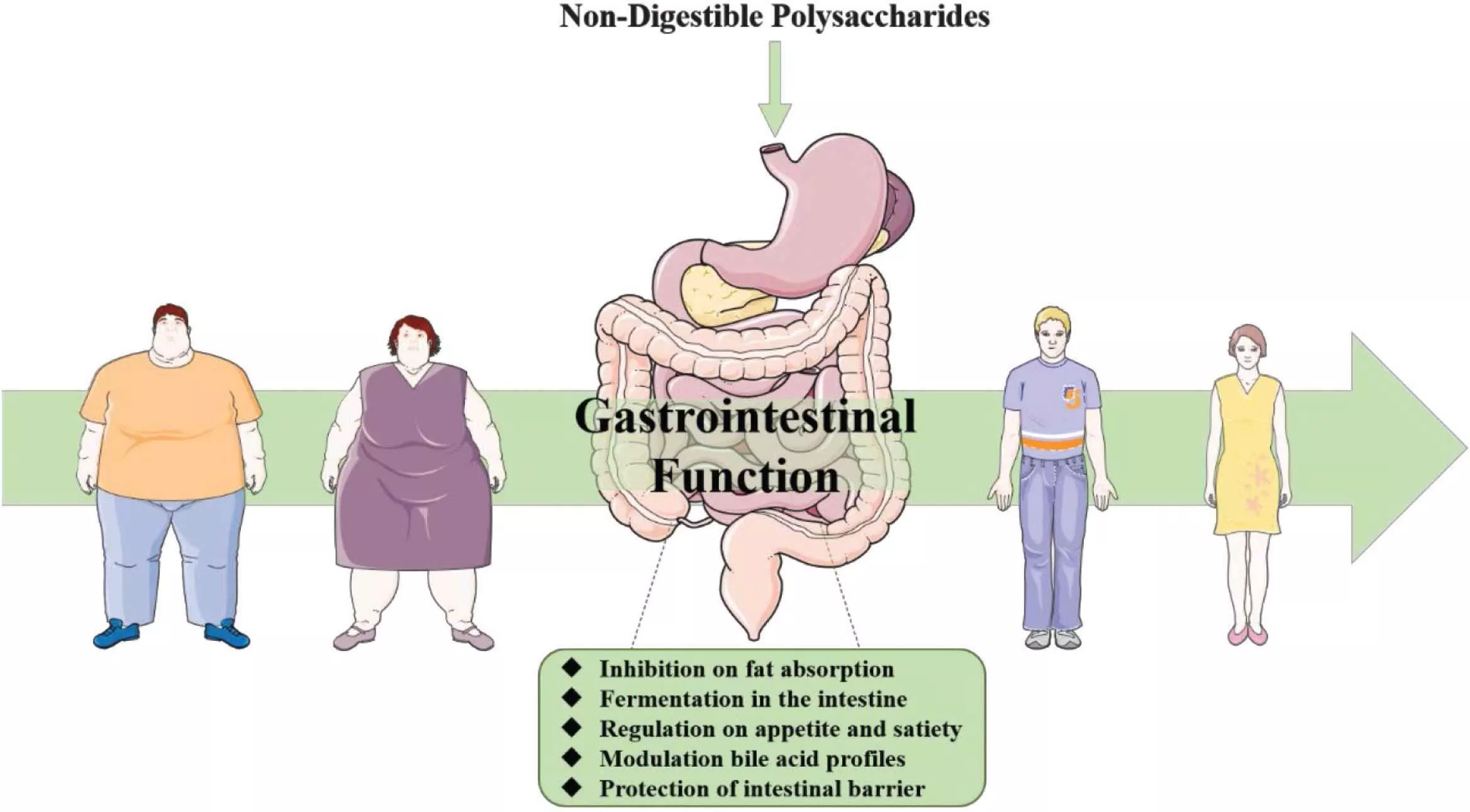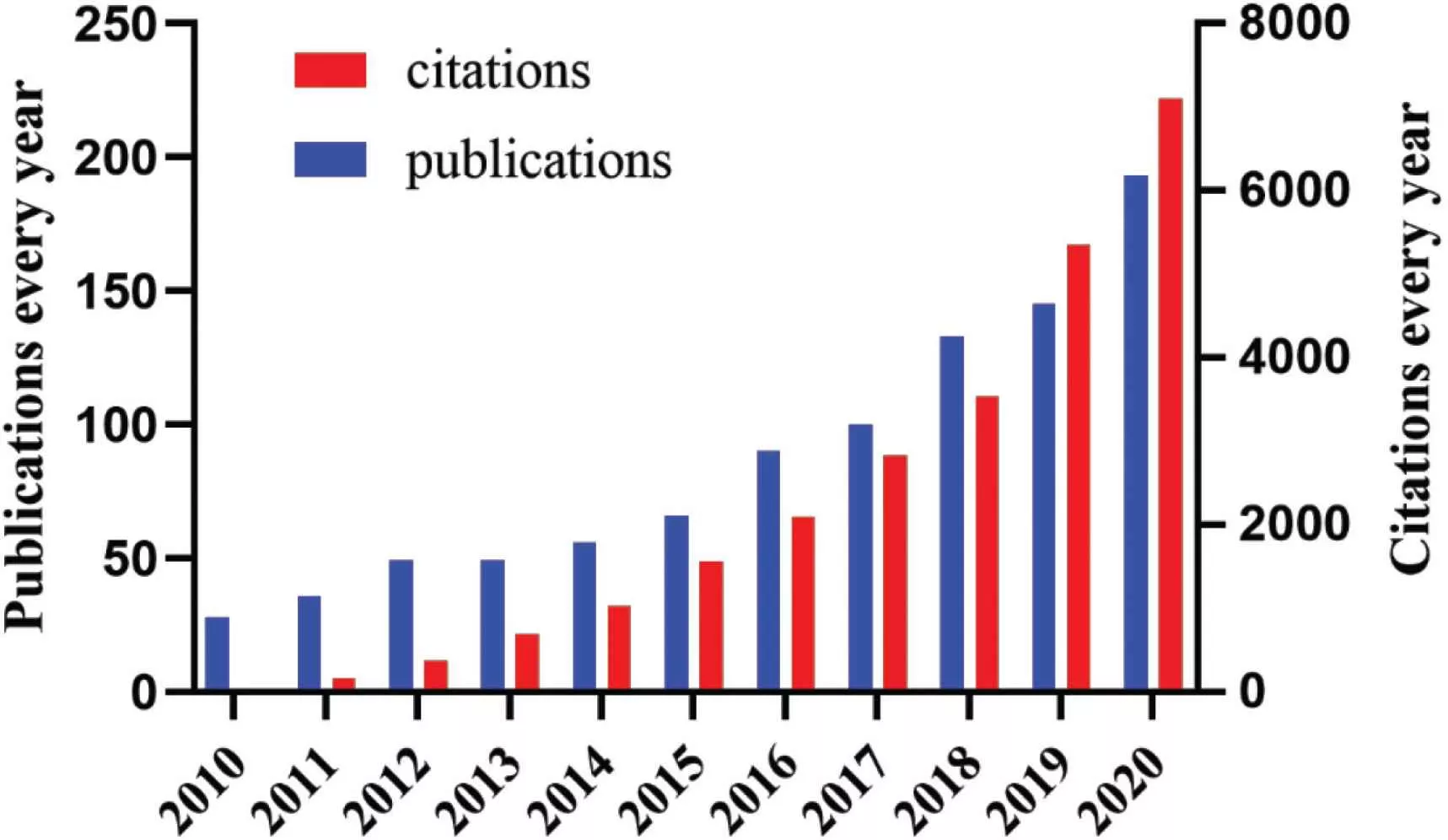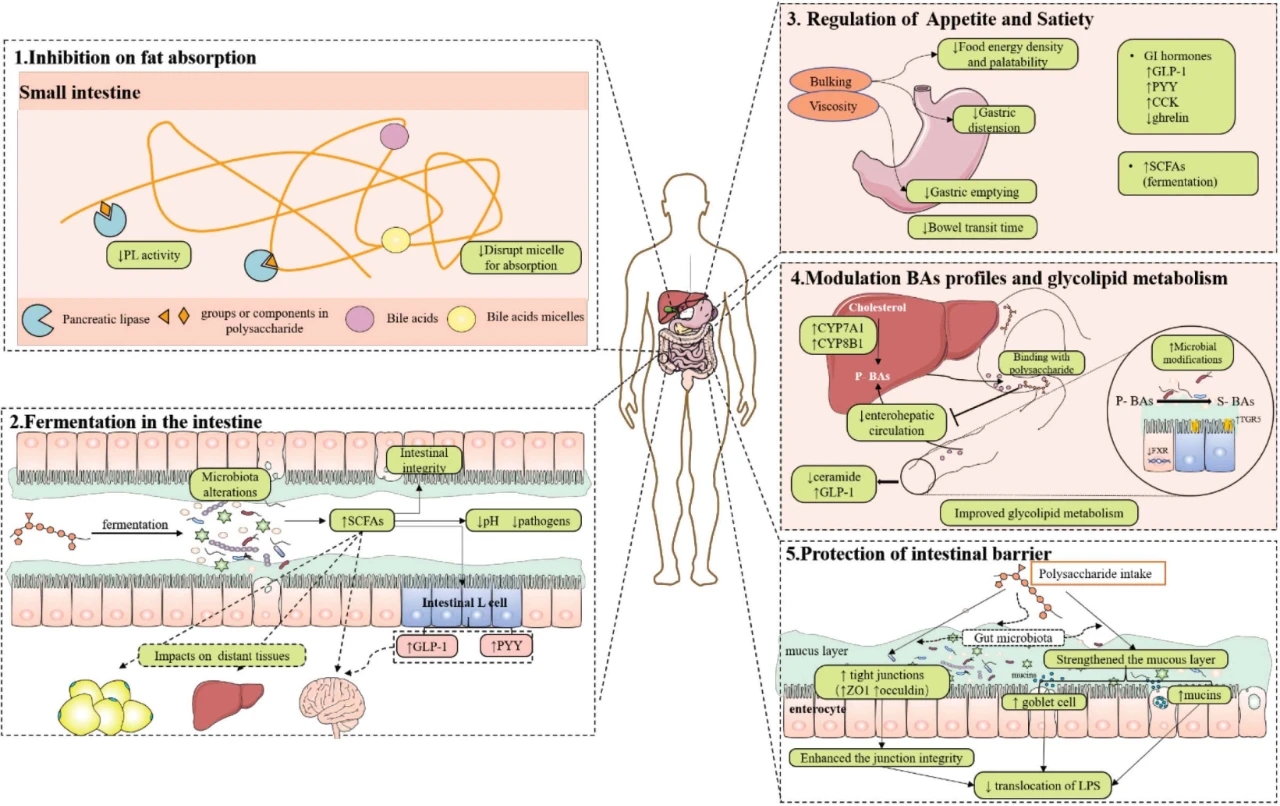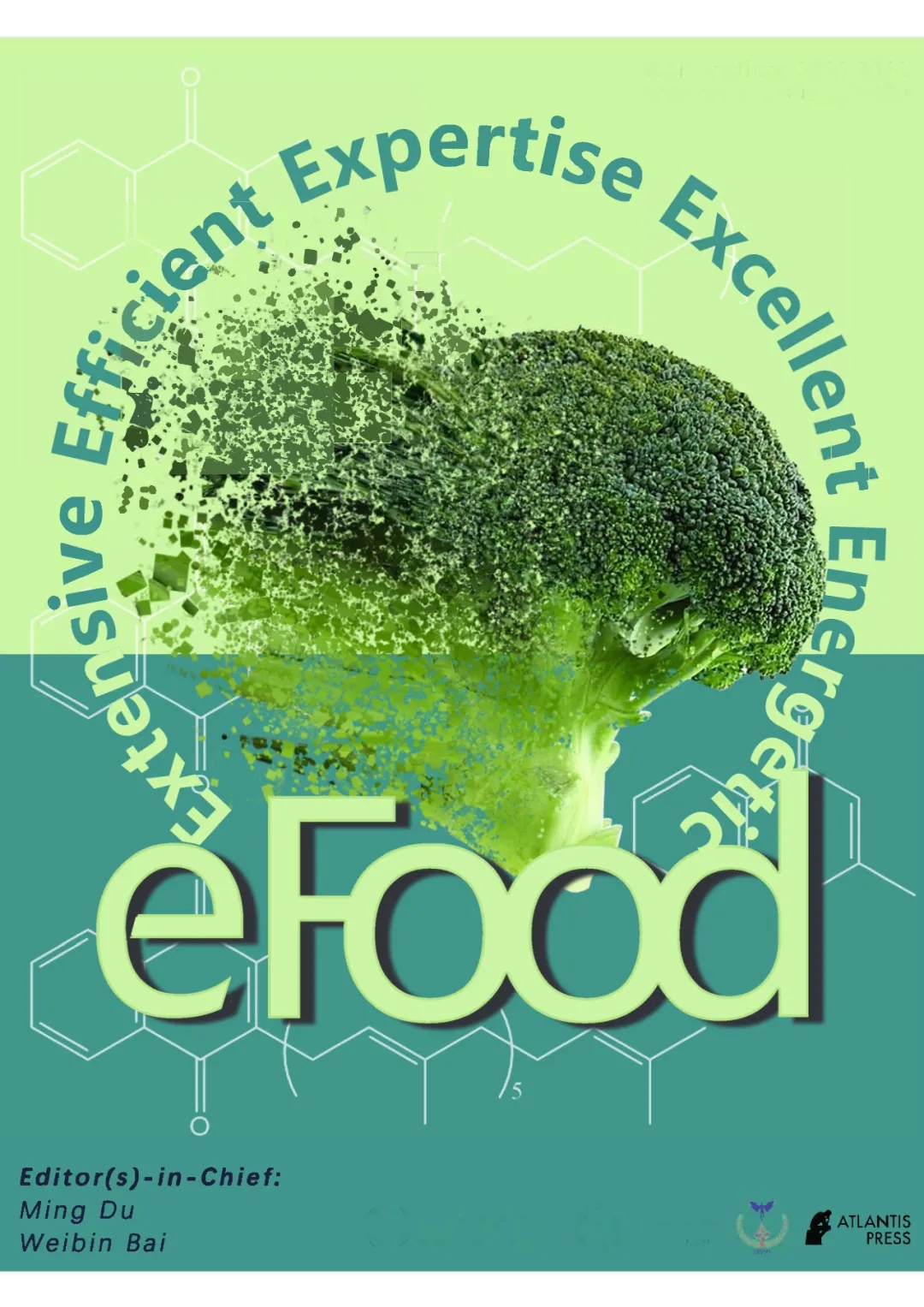 精选
精选
小编导读
如今,肥胖是对人类健康的一个巨大挑战,人们需要有效且低风险的膳食替代治疗。食用不可消化多糖(NDPs)被认为是一种很有前途的减肥方法。来自华南理工大学食品科学与工程学院、香港中文大学食品营养系和食品营养与健康学科创新引智基地(111基地)的研究人员在期刊eFood (ISSN: 2666-3066)上发表了题为“Behavior of Non-Digestible Polysaccharides in Gastrointestinal Tract: A Mechanistic Review of its Anti-Obesity Effect”的文章,综述了食用不可消化多糖(NDPs)在胃肠道内的行为研究进展,探讨了NDPs的减肥机制。
要点介绍
如今,肥胖作为一种脂肪储存过多或异常的流行病,已成为世界范围内严重的公共卫生问题,患病率逐年增长。根据世界卫生组织的数据,2016年,超过6.5亿人被诊断患有肥胖症,到2030年,将有10亿人受到影响。肥胖及其多种并发症,如高脂血症、2型糖尿病、某些癌症等,会导致患病者生活质量降低、死亡率增加,而且会带来巨额医疗费用负担。
由高能量摄入和低能量消耗引起的能量失衡是肥胖发生的根本原因,此外还有其他相关因素,包括遗传代谢、内分泌失调等。迄今为止,预防肥胖的策略主要包括抗肥胖药物、减肥手术、饮食和运动。其中,对抗肥胖的首选方法是坚持定期运动和低能量饮食,比如控制脂肪和糖的摄入量。此外,以前批准的抗肥胖药物,具有一定的副作用。通过胃分流术或胃束带手术减肥虽然比药物治疗更有效,但只有少数患者适合这种治疗方法。因此,近年来,人们一直在探索有效、易获得以及低风险的替代疗法。
作为一种天然产物,不可消化多糖(NDPs)在肥胖症研究中一直备受关注(图1)。它们广泛分布于植物、真菌和微生物中。越来越多的证据表明,它们可以通过调节脂质代谢、降低炎症水平、改善胰岛素抵抗等多种机制预防肥胖症的发生。生物利用度相对较低的NDPs在体内发挥抗肥胖作用的方式,如改变机体成分、改善代谢紊乱等,在很大程度上可能是基于其在胃肠道系统中的行为。本文综述了NDPs在胃肠道中的行为及其与胃肠道生理相关的潜在减肥机制,旨在为更好地理解NDPs对体重增加的控制提供一些重要的见解。
结果表明,与胃肠道内NDPs行为相关的减肥机制可能包括:(i)抑制脂肪吸收,(ii)改变肠道微生物群及其代谢产物,如短链脂肪酸,(iii)调节胆汁酸分布,(iv)调节食欲和饱腹感效应,保护肠道屏障。

图1. Graphical Abstract。

图2. 多糖与肥胖的研究趋势。数据来源于网站(http://apps.webofknowledge.com). 检索日期:2021年2月。

图3. NDPs在胃肠道过程中抑制肥胖的机制示意图。(1)NDPs调节脂肪吸收;(2) NDPs通过在肠道内发酵来改变肠道微生物群及其代谢产物;(3)NDPs通过提高胃肠饱腹感降低食物摄入量;(4)NDPs调节糖脂代谢;(5)NDPs保护肠道屏障,减轻代谢性内毒素血症。
研究结论:在这篇综述中,我们总结了NDPs在胃肠道中的行为,并着重介绍了NDPs的抗肥胖机制及其生理效应。结果表明,NDPs可以到达结肠并被结肠微生物利用。他们通过控制脂肪吸收、肠内发酵、调节胆汁酸分布、调节食欲和饱腹感以及通过恢复肠屏障改善代谢性内毒素血症等机制显示了对胃肠道内肥胖的治疗作用。
参考文献 References
[1] Sun L, Ma L, Ma Y, Zhang F, Zhao C, Nie Y. Insights into the role of gut microbiota in obesity: pathogenesis, mechanisms, and therapeutic perspectives. Protein Cell 2018;9:397–403.
[2] World Health Organization. Obesity. 2020. Available from: https://www.who.int/news-room/facts-in-pictures/detail/6- facts-on-obesity.
[3] Zhang WL, Zhu L, Jiang JG. Active ingredients from natural botanicals in the treatment of obesity. Obes Rev 2014;15:957–67.
[4] González-Muniesa P, Mártinez-González MA, Hu FB, Després JP, Matsuzawa Y, Loos RJF, et al. Obesity. Nat Rev Dis Primers 2017;3:17034.
[5] Ben Gara A, Ben Abdallah Kolsi R, Chaaben R, Hammami N, Kammoun M, Paolo Patti F, et al. Inhibition of key digestive enzymes related to hyperlipidemia and protection of liver-kidney functions by Cystoseira crinita sulphated polysaccharide in high- fat diet-fed rats. Biomed Pharmacother 2017;85:517–26.
[6] Liang Y, Lin C, Huang S, Xu Y. Traditional Chinese medicine and intestinal microbiota: a complementary and integrative health approach to ameliorate obesity-related diseases. Holist Nurs Pract 2019;33:259–65.
[7] Chater PI, Wilcox MD, Houghton D, Pearson JP. The role of seaweed bioactives in the control of digestion: implications for obesity treatments. Food Funct 2015;6:3420–7.
[8] Martel J, Ojcius DM, Chang CJ, Lin CS, Lu CC, Ko YF, et al. Anti- obesogenic and antidiabetic effects of plants and mushrooms. Nat Rev Endocrinol 2017;13:149–60.
[9] Zhang T, Yang Y, Liang Y, Jiao X, Zhao C. Beneficial effect of intestinal fermentation of natural polysaccharides. Nutrients 2018;10:1055.
[10] Shang W, Li H, Strappe P, Zhou Z, Blanchard C. Konjac gluco- mannans attenuate diet-induced fat accumulation on livers and its regulation pathway. J Funct Foods 2019;52:258–65.
[11] Joyce SA, Kamil A, Fleige L, Gahan CGM. The cholesterol- lowering effect of oats and oat beta glucan: modes of action and potential role of bile acids and the microbiome. Front Nutr 2019;6:171.
[12] Li L, Guo WL, Zhang W, Xu JX, Qian M, Bai WD, et al. Grifola frondosa polysaccharides ameliorate lipid metabolic disorders and gut microbiota dysbiosis in high-fat diet fed rats. Food Funct 2019;10:2560–72.
[13] Luo J, Qi J, Wang W, Luo Z, Liu L, Zhang G, et al. Antiobesity effect of flaxseed polysaccharide via inducing satiety due to leptin resistance removal and promoting lipid metabolism through the AMP-activated protein kinase (AMPK) signaling pathway. J Agric Food Chem 2019;67:7040–9.
[14] Sudirman S, Chang HW, Chen CK, Kong ZL. A dietary polysac- charide from Eucheuma cottonii downregulates proinflamma- tory cytokines and ameliorates osteoarthritis-associated cartilage degradation in obese rats. Food Funct 2019;10:5697–706.
[15] Wang S, Li Q, Zang Y, Zhao Y, Liu N, Wang Y, et al. Apple poly- saccharide inhibits microbial dysbiosis and chronic inflamma- tion and modulates gut permeability in HFD-fed rats. Int J Biol Macromol 2017;99:282–92.
[16] Kanwal S, Aliya S, Xin Y. Anti-obesity effect of Dictyophora indu- siata mushroom polysaccharide (DIP) in high fat diet-induced obesity via regulating inflammatory cascades and intestinal microbiome. Front Endocrinol 2020;11:558874.
[17] Ahmadi S, Nagpal R, Wang S, Gagliano J, Kitzman DW, Soleimanian-Zad S, et al. Prebiotics from acorn and sago pre- vent high-fat-diet-induced insulin resistance via microbiome- gut-brain axis modulation. J Nutr Biochem 2019;67:1–13.
[18] Zhang Y, Zuo J, Yan L, Cheng Y, Li Q, Wu S, et al. Sargassum fusiforme fucoidan alleviates high-fat diet-induced obesity and insulin resistance associated with the improvement of hepatic oxidative stress and gut microbiota profile. J Agric Food Chem 2020;68:10626–38.
[19] Li L, Yao H, Li X, Zhang Q, Wu X, Wong T, et al. Destiny ofDendrobium officinale polysaccharide after oral administration: indigestible and nonabsorbing, ends in modulating gut microbi- ota. J Agric Food Chem 2019;67:5968–77.
[20] Yu M, Xiao B, Hao X, Tan J, Gu J, Wang G, et al. Pumpkin poly- saccharide preparation, simulated gastrointestinal digestion, and in vivo biodistribution. Int J Biol Macromol 2019;141: 1293–303.
[21] Wang K, Cheng F, Pan X, Zhou T, Liu X, Zheng Z, et al. Investigation of the transport and absorption of Angelica sinensispolysaccharide through gastrointestinal tract both in vitro andin vivo. Drug Deliv 2017;24:1360–71.
[22] Hasjim J, Lavau GC, Gidley MJ, Gilbert RG. In vivo and in vitro starch digestion: are current in vitro techniques adequate?. Biomacromolecules 2010;11:3600–8.
[23] Minekus M, Alminger M, Alvito P, Ballance S, Bohn T, Bourlieu C, et al. A standardised static in vitro digestion method suitable for food - an international consensus. Food Funct 2014;5:1113–24.
[24] Wang M, Wichienchot S, He X, Fu X, Huang Q, Zhang B. In vitrocolonic fermentation of dietary fibers: fermentation rate, short- chain fatty acid production and changes in microbiota. Trends Food Sci Technol 2019;88:1–9.
[25] Chen P, Lei S, Chen Y, Chang Q, Zhang Y, Hu X, et al. Structural characterization of a novel galactoglucan from Fortunella mar- garita and its molecular structural change following simulated digestion in vitro. J Funct Foods 2020;71:104024.
[26] Wu DT, Nie XR, Gan RY, Guo H, Fu Y, Yuan Q, et al. In vitrodigestion and fecal fermentation behaviors of a pectic polysac- charide from okra (Abelmoschus esculentus) and its impacts on human gut microbiota. Food Hydrocolloid 2021;114:106577.
[27] ZhuK,YaoS,ZhangY,LiuQ,XuF,WuG,etal.Effectsofinvitrosaliva, gastric and intestinal digestion on the chemical properties, antioxidant activity of polysaccharide from Artocarpus hetero- phyllus Lam. (Jackfruit) Pulp. Food Hydrocolloid 2019;87:952–9.
[28] Zhou W, Yan Y, Mi J, Zhang H, Lu L, Luo Q, et al. Simulated digestion and fermentation in vitro by human gut microbiota of polysaccharides from bee collected pollen of Chinese wolfberry. J Agric Food Chem 2018;66:898–907.
[29] Huang F, Liu Y, Zhang R, Bai Y, Dong L, Liu L, et al. Structural characterization and in vitro gastrointestinal digestion and fermentation of litchi polysaccharide. Int J Biol Macromol 2019;140:965–72.
[30] DingQ,NieS,HuJ,ZongX,LiQ,XieM.Invitroandinvivogastrointestinal digestion and fermentation of the polysaccharide from Ganoderma atrum. Food Hydrocolloid 2017;63:646–55.
[31] Han R, Pang D, Wen L, You L, Huang R, Kulikouskaya V. In vitrodigestibility and prebiotic activities of a sulfated polysaccharide from Gracilaria Lemaneiformis. J Funct Foods 2020;64:103652.
[32] Chen G, Xie M, Wan P, Chen D, Ye H, Chen L, et al. Digestion under saliva, simulated gastric and small intestinal conditions and fermentation in vitro by human intestinal microbiota of polysaccharides from Fuzhuan brick tea. Food Chem 2018;244: 331–9.
[33] Di T, Chen G, Sun Y, Ou S, Zeng X, Ye H. In vitro digestion by saliva, simulated gastric and small intestinal juices and fermenta- tion by human fecal microbiota of sulfated polysaccharides fromGracilaria rubra. J Funct Foods 2018;40:18–27.
[34] Bai J, Li T, Zhang W, Fan M, Qian H, Li Y, et al. Systematic assess- ment of oat b-glucan catabolism during in vitro digestion and fermentation. Food Chem 2021;348:129116.
[35] El Kaoutari A, Armougom F, Gordon JI, Raoult D, Henrissat B. The abundance and variety of carbohydrate-active enzymes in the human gut microbiota. Nat Rev Microbiol 2013;11:497–504.
[36] Ajanth Praveen M, Karthika Parvathy KR, Balasubramanian P, Jayabalan R. An overview of extraction and purification tech- niques of seaweed dietary fibers for immunomodulation on gut microbiota. Trends Food Sci Technol 2019;92:46–64.
原文信息
Y. Zhang, Q. Xie, L. You, P. C. Cheung, Z. Zhao, "Behavior of Non-Digestible Polysaccharides in Gastrointestinal Tract: A Mechanistic Review of its Anti-Obesity Effect", eFood, 2021, DOI: 10.2991/efood.k.210310.001.

扫描二维码,获取英文原文
https://www.atlantis-press.com/journals/efood/125954168
关于期刊

eFood(eISSN 2666-3066)是完全由中国学者发起,与Atlantis Press合作出版的食品科学及工程领域国际期刊,以应对全球食品和健康方面的挑战。目前已发表内容涵盖食品化学、营养健康、食品安全与检测等领域,已获得13,000多次全文下载, 并已被食品科技领域国际刊物如Advanced Drug Delivery Reviews (IF 13.3),TrAC Trends in Analytical Chemistry (IF 9.801),Critical Reviews in Food Science and Nutrition (IF 7.862),Food Chemistry (IF 6.306) 等期刊引用多次。
eFood 采用钻石开放获取出版模式,作者和读者均无需付费。目前新投稿平均一审周期23.9天,文章接收后到快速上线平均3-5天。目前,期刊已被食品科学与技术领域著名国际数据库FSTA收录,同时已被Ulrichsweb, DOAJ, Google Scholar, 中国知网, 万方数据库等收录。
版权声明:
*本文内容由Atlantis Press中国办公室翻译编辑。中文内容仅供参考,一切内容以英文原版为准。如需转载,请在评论区留言,或联系xin.guo@atlantis-press.com。
![]()
Atlantis Press是科学、技术和医学(STM)领域的全球开放获取出版品牌,2006年创立于法国巴黎,在巴黎、阿姆斯特丹、北京、郑州和香港设有办事处。我们的使命是通过促进科研界和整个社会更有效地传播和交流知识来支持科学、技术和医学研究的进步。迄今,Atlantis Press的数字内容平台包含超过14万篇开放获取论文供读者免费下载阅读,每年产生2500多万下载量。Atlantis Press是施普林格·自然的一部分。
转载本文请联系原作者获取授权,同时请注明本文来自Atlantis Press科学网博客。
链接地址:https://wap.sciencenet.cn/blog-3453320-1287240.html?mobile=1
收藏


